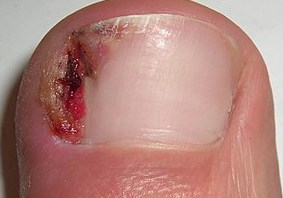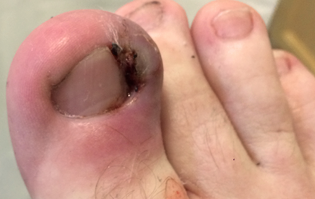Get your skin lumps remove with Amazing result.
We can remove all kinds of skin lumps, benign or cancerous. Simple lumps can be remove in the office. More complex lumps can be done in Hospital.
Ingrown Toenail.





What is an ingrown toenail?
It occurs when toenail has grown into the skin instead of over it. This most commonly occurs in the big toe, but it can also happen to other toes. when an ingrown toenail get infected. It may be painful, red, and swollen, and it may drain pus.
Anyone can get an ingrown toenail, but adults get them more than children do. People who have curved or thick nails are more likely to get an ingrown toenail.
What causes an ingrown toenail?
An ingrown toenail can have a number of different causes. Cutting your toenail too short or rounding the edge of the nail can cause it to grow into the skin. Wearing shoes or socks that don't fit well can also cause an ingrown toenail. If your shoes are too tight, they might press the nail into the toe and cause it to grow into the skin.
You can get an ingrown toenail if you hurt your toe, such as stubbing it. This can cause the nail to grow inward. Repeating an activity that injuries the nail, such as kicking a soccer ball, can also cause an ingrown nail.
What are the symptoms?
The main symptom of an ingrown toenail is the pain from the nail growing into the skin instead of over it. If the ingrown toenail gets infected, it might be swollen or red, and it might drain pus. The area around the ingrown toenail is often painful.
How is an ingrown toenail diagnosed?
Your doctor will do a physical exam to diagnose an ingrown toenail. He or she will look at your toe where the nail has grown into the skin.
How is it treated?
You can try the following steps at home to relieve the pain caused by your ingrown toenail and help the nail to grow out naturally:
- Soak your sore toe in warm water for 15 minutes 2 to 3 times each day.
- Wedge a piece of small cotton, such as part of a cotton ball, under the corner of your ingrown nail. This will help lift the nail off of the skin.
- Soak your toe and change the piece of cotton each day until the nail grows out and can be trimmed.
- Do not use a sharp object like manicure scissors to dig under your nail, because the toe might get infected.
- Do not try to use a needle to drain the pus from your toe. This could make the infection worse.
- While your ingrown toenail is healing, wear comfortable shoes or sandals that do not press on your toe.
Use these home treatment steps for 3 days. If no improvement call your doctor if your toe is red, warm, swollen, or drains pus, or if there are red streaks leading from your toe.
Your doctor might give you antibiotics.
If your toenail is very ingrown, wedge excision of part of the ingrown nail is the best treatment.
During this surgery, the doctor will numb your toe. Then he or she will cut the edge of the ingrown toenail and pull out the piece of nail. To prevent the nail from growing into the skin again, your doctor might destroy all or part of the nail root.
After the surgery it is important to take care of your toe so that it can heal. Your doctor will give you specific instructions to follow. He or she may tell you to:
- Soak your toe in warm water for 15 minutes 2 to 3 times each day.
- Apply a thin layer of petroleum jelly, such as Vaseline, 2 times each day on the toe where the nail was removed.
- Wear a bandage on your toe.
- Wear loose-fitting shoes that don't press on the toe where the nail was removed.
How can ingrown toenails be prevented?
Wearing roomy and comfortable shoes and socks that do not press on your toes.
Be sure to trim your toenails properly. You can do this by cutting your toenail straight across, not curved.
Make sure you do not cut your toenail too short. You can also leave your toenail a little longer at the corners to help it grow over the skin.
People with diabetes have a hard time feeling their toes and might cut themselves without realizing it.
Peripheral arterial disease can cause toes to be very painful.
Most lesions can be removed on the same day under local anaesthetic. The cost is usually $150 to $250 out of pocket with medicare.
More bigger and complex lesion can be remove in Hospital. A different fee will apply.
We also offer laser treatment to reduce scaring after surgery
or call us: 02 92213919
Keyhole surgery Centre
Dr Clement Tsang
Level 8, 187 Macquarie st Sydney 2000
Level 2, 31 Dora st Hurstville 2220
Enter your text here...